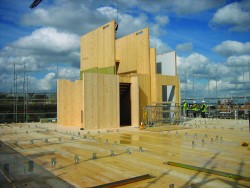Robin Lancashire, Senior Timber Frame Consultant at TRADA picks out some key issues surrounding the durability of cross-laminated timber (CLT) and what to remember during the construction phase.
Building in Britain means that we need to manage the effects of moisture, both during the construction phase and when buildings are in use. This is particularly important with timber which can be at risk of decay when it is exposed to high levels of moisture for a prolonged period of time.
Fortunately, with good design and robust working practices this does not need to be a problem. The UK has a maritime climate, with warm moist air from the Atlantic Ocean keeping temperatures mild throughout the year and regular rainfall making the UK wetter than many places in continental Europe. This creates challenges for the construction industry when using modern methods of construction, as weather sensitive materials arrive onsite earlier in the build programme and may need extra care before a weather tight shell is achieved.
While cross-laminated timber (CLT) buildings can be erected quickly, it still takes several weeks to build larger structures. During this phase, and when the erectors depart leaving the building in the hands of the main contractor, it is essential that good water management procedures exist. Short term surface wetting is generally acceptable as the moisture has insufficient time to penetrate deep into the timber before wind and sun lead to evaporation, but long-term wetting and pooling of water can raise core moisture contents, particularly on horizontal surfaces. If materials that don’t offer high levels of breathability are installed over saturated timber, this moisture takes a very long time to escape and in the meantime there is a risk of fungal decay developing. The large volumes of timber used in CLT mean that large quantities of moisture can be absorbed. Glue lines and the cross-laminations mean that CLT absorbs moisture and dries differently to solid timber. There is further work to be done to fully understand how moisture moves through CLT panels and the time it takes to dry if saturated and/or above the fungal moisture content threshold.
The CLT industry in the UK is now mature and there are many examples of successful buildings using this method. However, as in other forms of construction there have also been failures – and with CLT this has tended to be caused by high moisture levels. The problems have been traced to either trapped construction moisture, poor design or leaks from the failure of other components.
It is likely that many main contractors are used to working with other structural materials which are not so sensitive to trapped moisture and they do not appreciate the importance of installing a weathertight shell as soon as practically possible. The CLT industry should increase the help and advice that they provide to main contractors, so that they fully understand this importance. They can work with them to minimise exposure through good water management and discuss phasing of critical weatherproofing works.
To continue reading this article, visit: Offsite Magazine Issue 12









